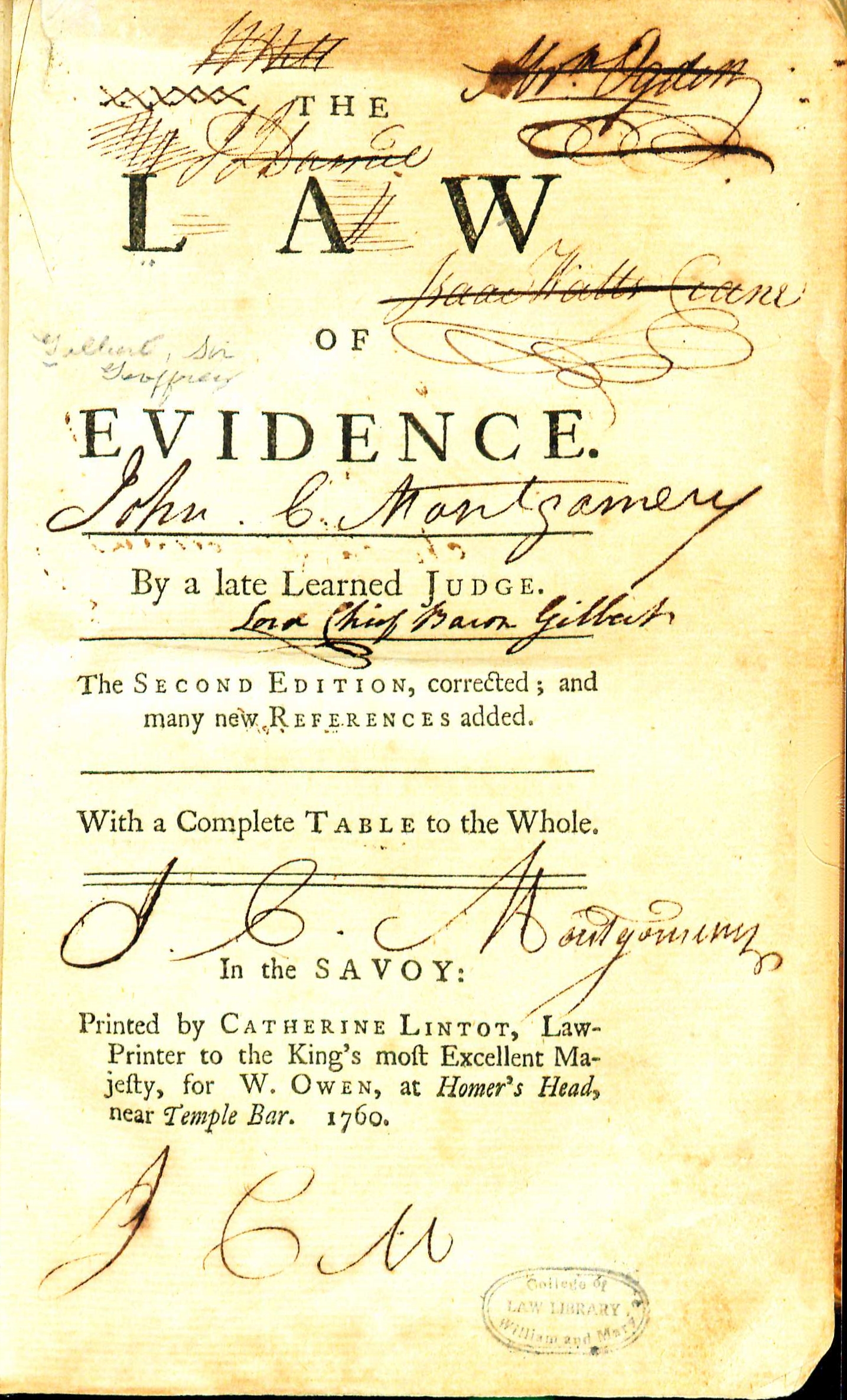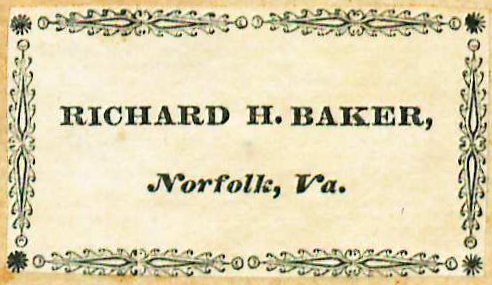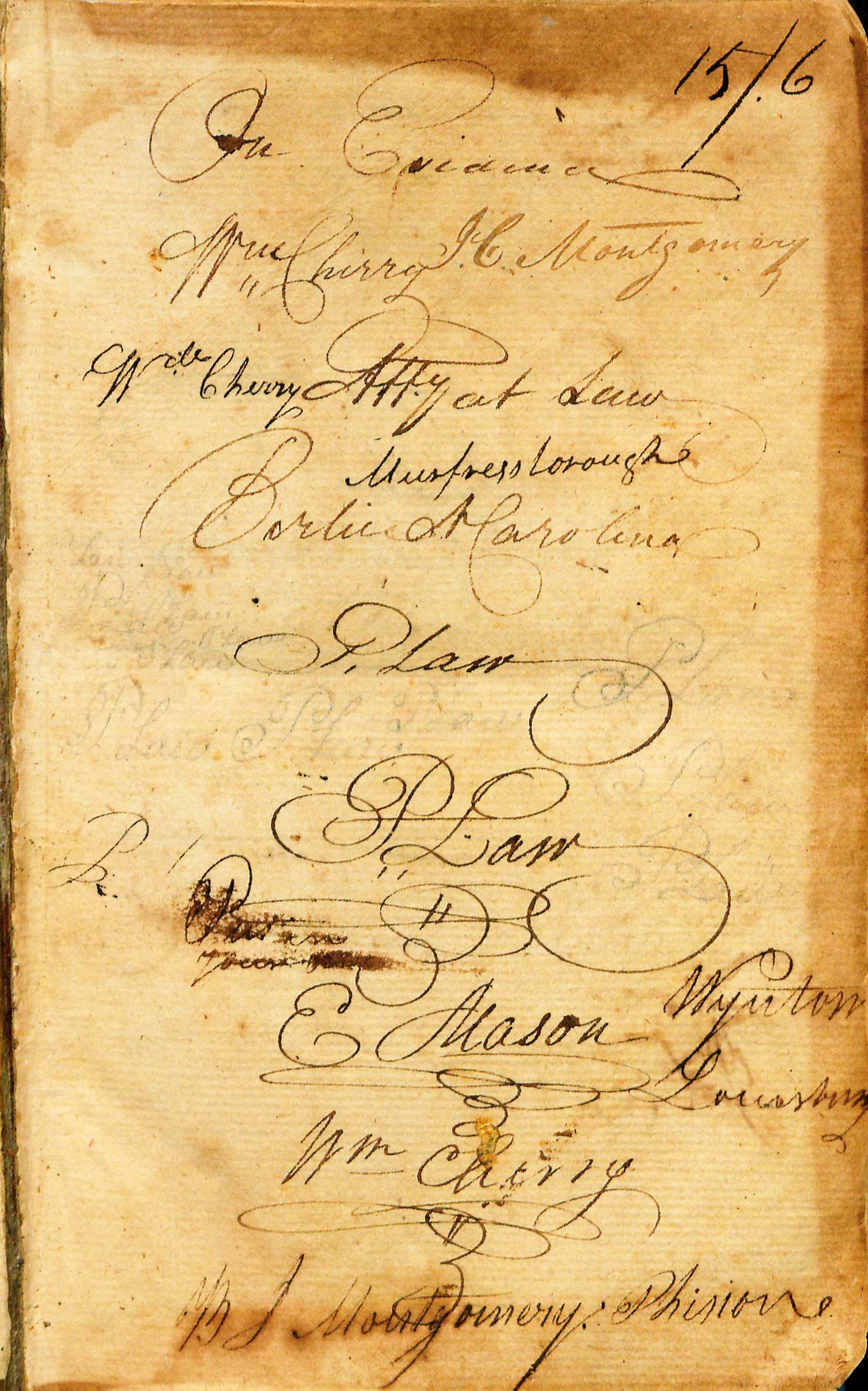Difference between revisions of "Law of Evidence"
(Created page with "{{DISPLAYTITLE:''The Law of Evidence''}} ===by Geoffrey Gilbert=== __NOTOC__ {{BookPageInfoBox |imagename= |link=https://catalog.swem.wm.edu/law/Record/532190 |shorttitle=The ...") |
(Intro paragraphs by Michelle Prendergast.) |
||
| Line 3: | Line 3: | ||
__NOTOC__ | __NOTOC__ | ||
{{BookPageInfoBox | {{BookPageInfoBox | ||
| − | |imagename= | + | |imagename=GilbertLawOfEvidence1760TitlePage.jpg |
|link=https://catalog.swem.wm.edu/law/Record/532190 | |link=https://catalog.swem.wm.edu/law/Record/532190 | ||
|shorttitle=The Law of Evidence | |shorttitle=The Law of Evidence | ||
| Line 14: | Line 14: | ||
|pages=289, 75 | |pages=289, 75 | ||
|desc=4to. (22 cm.) | |desc=4to. (22 cm.) | ||
| − | }} | + | }}{{BookPageBookplate |
| + | |imagename=GilbertLawOfEvidence1760Bookplate.jpg | ||
| + | |display=left | ||
| + | |caption=Bookplate of Richard H. Baker, front pastedown. | ||
| + | }}Geoffrey Gilbert (1674-1726) was admitted to Inner Temple in 1962 and joined the bar in 1968. Through connections to Sir Matthew Hale, Gilbert was located in whig politics and Hale’s approach to common-law. He became chief baron of the Irish exchequer in 1715 and rose to the position of chief baron of exchequer of England in 1725.<br /> | ||
| + | <br /> | ||
| + | As a lawyer and judge, Gilbert had a high reputation, but his decisions were not widely reported or cited. Gilbert was more significantly regarded posthumously for his engagement in a general legal treatise on England’s ‘Institutional’ model. It was separated into sections of Persons, Things, and Actions, the text of which was likely meant for publication.<br /> | ||
| + | <br /> | ||
| + | While the collection involved at least two other contributors, Gilbert was instrumental in the structure, writing of text, and editing of others’ contributions. However, Gilbert discontinued his participation before 1710, and the sections were ultimately not published as a collection. Some of Gilbert’s manuscripts were left in Ireland, while twelve sections were published fragmentally as individual treatises from 1730-1763. The section, Evidence, was already in manuscript circulation as an individual treatise in 1710 and is cited as Gilbert’s most known and influential treatise.<br /> | ||
| + | <br /> | ||
| + | The Law of Evidence was originally published in 1754 and was expanded and republished in six more editions, significantly impacting treatment of the relevant law into the mid nineteenth century. It was acclaimed by Blackstone as “a work which it is impossible to abstract or abridge without losing some beauty and destroying the chain of the whole.”<ref>W. Blackstone, ''Commentaries on the Laws of England'', 3 (1825): 367., quoted in John H. Langbein, "Historical Foundations of the Law of Evidence: A View from the Ryder Sources," ''Columbia Law Review'' 96, no. 5 (1996): 1172-1173.</ref> Gilbert’s ''Law of Evidence'' is noted for distinguishing between written and unwritten forms of evidence, which were enveloped in his principle of “the best evidence rule”.<ref>John H. Langbein, "Historical Foundations of the Law of Evidence: A View from the Ryder Sources," ''Columbia Law Review'' 96, no. 5 (1996): 1172-1173.</ref> The premise of Gilbert’s principle is that secondary documentation will not be acceptable evidence when the preferred, original document is available.<br /> | ||
| + | <br /> | ||
| + | Gilbert’s writings are indicative of Whig interpretations of law during the early eighteenth century and on the development of the modern, legal treatise. However, the nature of publication has led some to question attribution of ''Evidence'' and other sections of the treatise to Gilbert.<ref>M. McNair, “Oxford Dictionary of National Biography,” Oxford University Press, 2014, http://www.oxforddnb.com/view/article/10688?docPos=1.</ref> | ||
| + | |||
==Evidence for Inclusion in Wythe's Library== | ==Evidence for Inclusion in Wythe's Library== | ||
| − | + | [[File:GilbertLawOfEvidence1760Inscriptions.jpg|left|thumb|350px|<center>Inscriptions, front flyleaf.</center>]] | |
==Description of the Wolf Law Library's copy== | ==Description of the Wolf Law Library's copy== | ||
Bound in recent limp vellum. | Bound in recent limp vellum. | ||
Revision as of 17:46, 10 November 2014
by Geoffrey Gilbert
| The Law of Evidence | |
|
Title page from The Law of Evidence, George Wythe Collection, Wolf Law Library, College of William & Mary. | |
| Author | Geoffrey Gilbert |
| Published | London, In the Savoy: Printed by Catherine Lintot ... for W. Owen |
| Date | 1760 |
| Language | English |
| Pages | 289, 75 |
| Desc. | 4to. (22 cm.) |
Geoffrey Gilbert (1674-1726) was admitted to Inner Temple in 1962 and joined the bar in 1968. Through connections to Sir Matthew Hale, Gilbert was located in whig politics and Hale’s approach to common-law. He became chief baron of the Irish exchequer in 1715 and rose to the position of chief baron of exchequer of England in 1725.
As a lawyer and judge, Gilbert had a high reputation, but his decisions were not widely reported or cited. Gilbert was more significantly regarded posthumously for his engagement in a general legal treatise on England’s ‘Institutional’ model. It was separated into sections of Persons, Things, and Actions, the text of which was likely meant for publication.
While the collection involved at least two other contributors, Gilbert was instrumental in the structure, writing of text, and editing of others’ contributions. However, Gilbert discontinued his participation before 1710, and the sections were ultimately not published as a collection. Some of Gilbert’s manuscripts were left in Ireland, while twelve sections were published fragmentally as individual treatises from 1730-1763. The section, Evidence, was already in manuscript circulation as an individual treatise in 1710 and is cited as Gilbert’s most known and influential treatise.
The Law of Evidence was originally published in 1754 and was expanded and republished in six more editions, significantly impacting treatment of the relevant law into the mid nineteenth century. It was acclaimed by Blackstone as “a work which it is impossible to abstract or abridge without losing some beauty and destroying the chain of the whole.”[1] Gilbert’s Law of Evidence is noted for distinguishing between written and unwritten forms of evidence, which were enveloped in his principle of “the best evidence rule”.[2] The premise of Gilbert’s principle is that secondary documentation will not be acceptable evidence when the preferred, original document is available.
Gilbert’s writings are indicative of Whig interpretations of law during the early eighteenth century and on the development of the modern, legal treatise. However, the nature of publication has led some to question attribution of Evidence and other sections of the treatise to Gilbert.[3]
Evidence for Inclusion in Wythe's Library
Description of the Wolf Law Library's copy
Bound in recent limp vellum.
View this book in William & Mary's online catalog.
References
- ↑ W. Blackstone, Commentaries on the Laws of England, 3 (1825): 367., quoted in John H. Langbein, "Historical Foundations of the Law of Evidence: A View from the Ryder Sources," Columbia Law Review 96, no. 5 (1996): 1172-1173.
- ↑ John H. Langbein, "Historical Foundations of the Law of Evidence: A View from the Ryder Sources," Columbia Law Review 96, no. 5 (1996): 1172-1173.
- ↑ M. McNair, “Oxford Dictionary of National Biography,” Oxford University Press, 2014, http://www.oxforddnb.com/view/article/10688?docPos=1.


